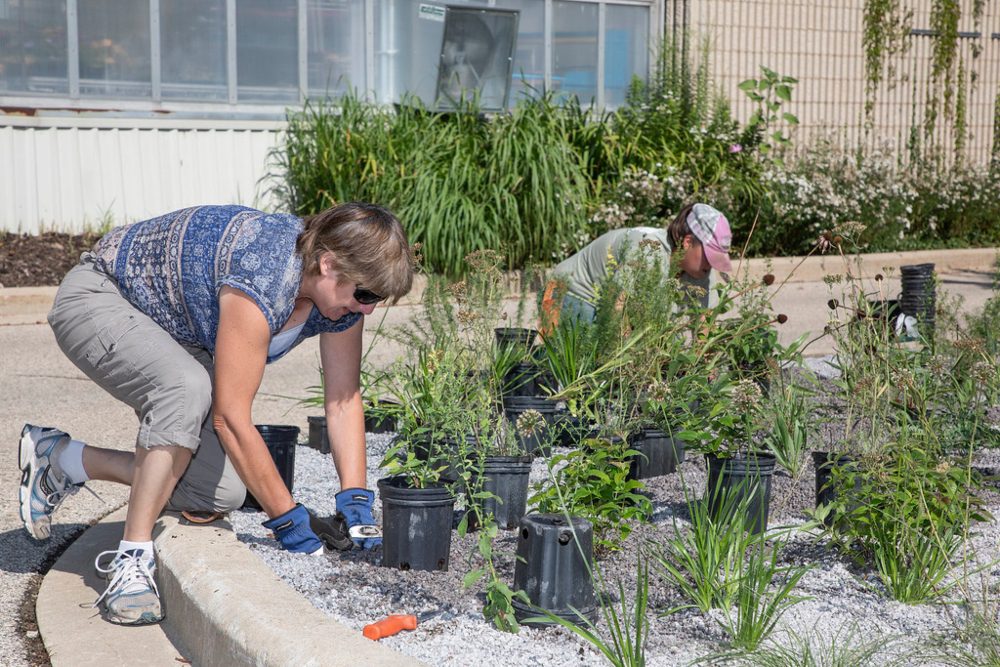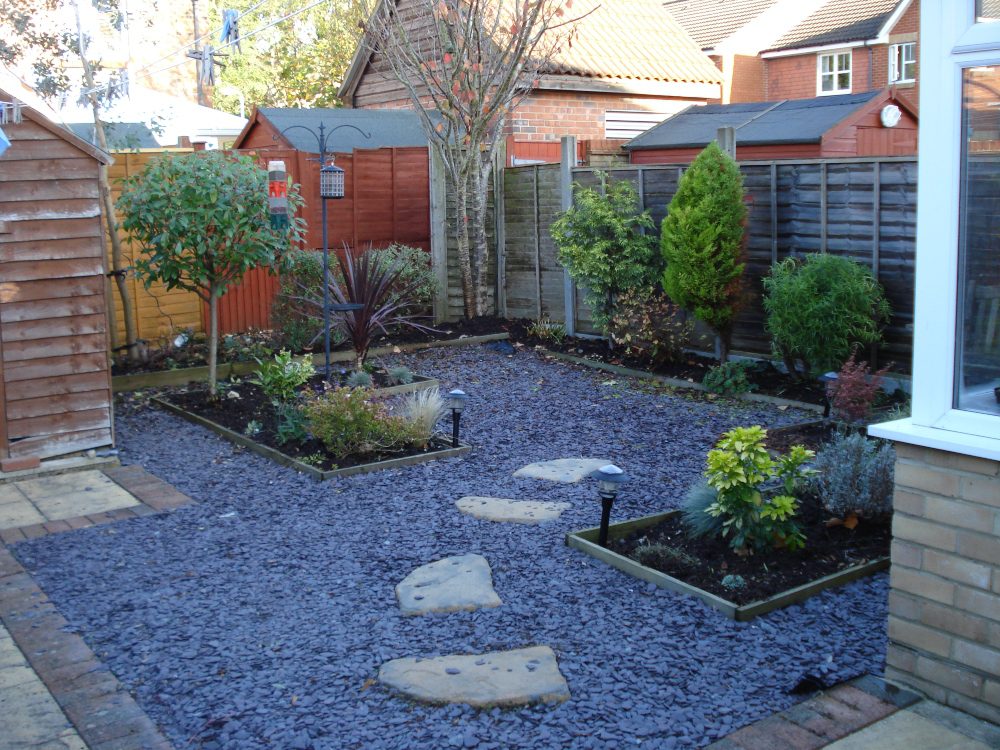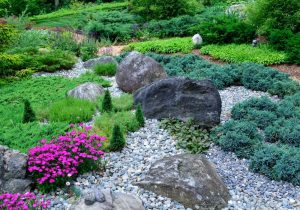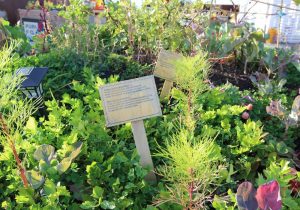
Gravel gardens are a beautiful and practical solution for low-maintenance landscaping. These spaces combine the elegance of natural stone with versatile plant choices. Ideal for various climates, gravel gardens require minimal watering and upkeep.
This article offers tips and ideas for designing your gravel garden. We also look at plant selection, layout, and maintenance strategies to create a stunning, sustainable outdoor space.
Basics of Gravel Garden
Contents
Gravel gardens are becoming a popular choice for homeowners and garden enthusiasts. They offer an aesthetically pleasing and environmentally friendly approach to landscaping. This section delves into what gravel gardens are and why they’re beneficial, especially in various climate conditions.
What are Gravel Gardens?
A gravel garden is a type of garden where gravel forms the main ground cover. Drought-resistant plants and hardy shrubs often accompany it. This setup reduces the need for water, making it an eco-friendly option. The benefits of a gravel garden include low maintenance, improved drainage, and a natural, modern aesthetic. Gravel gardens are particularly suitable for areas with limited water resources.
Suitability for Different Climates
Gravel gardens adapt well to various climates but are especially suited to dry, arid conditions. In these environments, they support plant growth without requiring extensive watering. However, with the right plant choices and setup, a gravel garden can also thrive in cooler, wetter climates. The key is ensuring proper drainage and selecting plants that can handle the specific conditions of your area.
Design Principles
Designing a gravel garden is both an art and a science. This section focuses on the fundamental principles that guide the creation of a stunning and functional gravel garden. From selecting the correct type of gravel to considering the overall layout, each aspect plays a crucial role in the garden’s success.
The principles outlined here ensure that your gravel garden is beautiful and practical.
Choosing the Right Gravel
Selecting the appropriate gravel is a critical step in designing your gravel garden. The type of gravel you choose influences the garden’s appearance, functionality, and maintenance. We’ll explore various factors when picking the perfect rock for your garden.
Types of Gravel
Gravel comes in various shapes, sizes, and colors. Options range from pea gravel, known for its smooth, round texture, to sharper-edged crushed stone. The choice depends on the garden’s style and the desired comfort for walking. River rock or pea gravel is ideal for a more natural look, while crushed stone can create a more dramatic and contemporary appearance.
Color and Aesthetic Appeal
The color of the gravel can significantly impact the garden’s overall look. Neutral colors like gray or beige blend well with most landscapes, while bolder hues can be used to create striking contrasts. Consider the color of your home’s exterior and existing landscaping to ensure a cohesive design.
Functional Considerations
The size of the gravel affects drainage and foot traffic comfort. Smaller stones are more comfortable to walk on but can shift more quickly, while larger stones stay in place better but can be rougher underfoot. Also, consider the local climate; larger gravel can aid in better drainage in areas with heavy rain.
Environmental Factors
Opt for locally sourced gravel to reduce environmental impact and support local businesses. Additionally, consider the sustainability of the rock. Some types are more eco-friendly, having minimal impact on their extraction environment.
Suitable gravel is essential in creating a practical and appealing gravel garden. It sets the foundation for the entire landscape, influencing the garden’s aesthetic and functional aspects.
Layout Considerations for Aesthetics and Functionality
Designing the layout of a gravel garden is a crucial step in achieving visual appeal and practical use. This process involves thoughtful space planning, ensuring the garden is beautiful and functional.
Defining Spaces
Start by defining different areas within the garden. Consider how each space will be used for seating, walking, or showcasing specific plants. Use gravel color or size variations to differentiate these areas, adding depth and interest to the overall design.
Pathways and Circulation
Pathways are essential for guiding movement through the garden. They should be wide enough for comfortable passage and made with smoother gravel for easy walking. Curved tracks can create a more natural and inviting flow, while straight paths offer a sense of order and formality.
Plant Bed Placement
The placement of plant beds is integral to the garden’s aesthetics. Arrange them to create balance and harmony. Consider the height, color, and texture of plants when positioning them. Taller plants can serve as focal points while lower-growing species can fill in around them.
Sunlight and Shade
Understand the patterns of sunlight and shade in your garden. Place sun-loving plants in areas with ample light and shade-loving plants in more excellent, shadowed areas. This not only ensures the health of the plants but also contributes to the visual dynamics of the space.
Integration with Existing Features
Incorporate landscape features like trees, shrubs, or water elements into your design. It helps create a sense of continuity and belonging, making the gravel garden feel like a natural extension of your outdoor space.
By focusing on these layout considerations, your gravel garden will be a place of beauty and a functional and harmonious part of your home’s outdoor environment.

Balancing Color and Texture
Achieving the right balance of color and texture is vital in creating a visually stunning gravel garden. This balance enhances the garden’s overall appeal and creates harmony.
Understanding Color Schemes
Start by choosing a color palette. You can opt for a monochromatic scheme for a subtle, cohesive look or a contrasting palette for more vibrancy. Consider the colors of the gravel, plants, and any garden features. They should complement each other and the overall theme of your garden.
Textural Contrasts
Texture plays a crucial role in adding depth and interest. Mix smooth, round gravels with rough, angular ones to create contrast. Similarly, combine plants with different leaf sizes and shapes. For instance, feathery grasses next to broad-leafed plants can make an appealing contrast.
Seasonal Considerations
Think about how colors and textures will change throughout the seasons. Choose plants that offer varied hues and textures in different seasons. This approach ensures your gravel garden remains visually attractive all year round.
Accentuating with Garden Art
Garden art or features like sculptures and rocks can add extra layers of color and texture. These elements serve as focal points and add a unique touch to the garden. Choose pieces that complement the garden’s style and color scheme.
Balancing color and texture is more than just aesthetics; it’s about creating a gravel garden that is a feast for the eyes and a serene retreat. With thoughtful consideration, your gravel garden can become a harmonious blend of hues and textures that delight the senses.
Incorporating Pathways and Edging
Pathways and edging are crucial elements in a gravel garden. They define spaces, guide movement, and contribute to the overall aesthetic. This section focuses on effectively incorporating these features for both beauty and function.
Designing Pathways
The design of pathways should consider both practicality and visual appeal. Determine the main travel routes and create paths that flow naturally within the space. Materials like stepping stones or different colored gravel can add interest. Ensure the pathways are wide enough for comfortable passage and consider accessibility for all users.
Material Choices for Pathways
Choose materials that complement the garden’s style. Smooth pebbles or finely crushed gravel are comfortable underfoot and work well for frequently used paths. For a more rustic look, larger stones or flagstones can be used. The material should be durable and suitable for local weather conditions.
Creating Effective Edging
Edging is essential to keep gravel in place and maintain clean lines between different areas. It can be as simple as a metal or plastic border or more elaborate like brick or natural stone. The choice of edging should match the overall design and help contain the gravel, preventing it from spilling into plant areas or lawns.
Integrating Edging with the Landscape
Edging should blend seamlessly with the garden. It can be subtle, almost hidden, or used as a decorative element. In some designs, plants or grasses spilling over the edges can soften the look, while in others, a crisp, precise line might be more desirable.
Incorporating pathways and edging thoughtfully enhances the functionality and aesthetic of your gravel garden. They provide structure and delineation, creating a cohesive and inviting outdoor space.
Focal Points and Garden Features
Focal points and garden features play a pivotal role in elevating the visual interest of a gravel garden. They draw the eye, add character, and create engaging spaces within the park.
Establishing Focal Points
A focal point is an area or feature that immediately captures attention. This could be a sculpture, a unique plant, a water feature, or a beautifully designed seating area. The key is to choose something that stands out but still feels integrated with the overall design. Position these focal points strategically to be viewed from various angles and locations within the garden.
Using Plants as Natural Focal Points
Due to their size, color, or unique form, certain plants can serve as natural focal points. Consider large, sculptural plants like agaves or ornamental grasses. These plants can break the monotony and add a dynamic element to the gravel landscape.
Incorporating Water Features
Water features like a small pond, fountain, or birdbath can enhance the peaceful ambiance of a gravel garden. The sound of water adds a soothing element, and the feature becomes a central point of interest. Ensure the style of the water feature complements the garden’s overall theme.
Adding Artistic Elements
Art pieces, whether modern sculptures or rustic, reclaimed items, can add a unique touch to your gravel garden. Choose art that reflects your style and enhances the garden’s atmosphere. Remember, the goal is to create a cohesive look, so the art should harmonize with the garden’s design.
Integrating Seating and Structures
Benches, gazebos, or pergolas can also serve as focal points. These structures provide functional spaces to relax and enjoy the garden while adding an architectural element to the design. Position them to offer the best views of the garden or to be enveloped by the surrounding plant life.
Finding the right focal points and garden features lets you create a visually engaging gravel garden that reflects your style and enhances the overall garden experience.
Scale and Proportion in Design
Scale and proportion are essential for creating a harmonious and balanced space in a gravel garden. This involves considering the size relationships between different elements of the park.
Understanding Scale
Scale refers to the size of garden elements relative to each other and the overall space. Prominent features in a small garden can overwhelm the room, while too many small pieces in a large park can appear cluttered and disjointed. Aim for a balance, choosing features and plants that are proportional to the size of your garden.

Proportion Between Elements
Proportion is about the balance between different elements within the garden. For example, a large, open gravel area might be balanced with a proportionately large plant bed or a substantial garden feature. Similarly, smaller garden areas can complement finer-textured gravel and smaller plants or features.
Considering Viewer Perspective
Think about how the garden will be viewed and from where. Elements closer to the viewing point can be more minor, creating a sense of depth, while those further away can be more extensive. This perspective plays a significant role in how the scale and proportion of the garden are perceived.
Harmonizing with Existing Structures
The garden should also scale and proportionate with existing structures, like your home or outbuildings. The size and style of these structures can guide your choices in the park to ensure a cohesive look.
Harmony with the Surrounding Landscape
Creating a gravel garden that harmoniously blends with the surrounding landscape is critical to a cohesive and natural-looking outdoor space. This involves considering the broader environment and ensuring that your garden complements it.
Observing the Natural Environment
Start by observing the natural landscape around your property. Take note of the dominant colors, textures, and types of vegetation. Your garden should feel like a natural extension of these elements rather than an isolated or contrasting feature.
Reflecting on the Local Flora
Incorporate plants native to your area or those that mirror the local flora. This ensures that your garden is in harmony with its surroundings, promotes biodiversity, and supports local wildlife.
Aligning with Architectural Styles
Consider the architectural style of your home and nearby structures. The design of your gravel garden should complement these styles. For instance, a modern minimalist house might pair well with a garden featuring clean lines and a simple color palette. At the same time, a traditional cottage could suit a more rustic, informal garden design.
Using Natural Materials
Choose materials commonly found in your local area to reinforce the connection to the landscape. It could include using locally sourced gravel, stones, and reclaimed materials. Using natural materials enhances the aesthetic appeal and reduces the environmental impact.
Blending Boundaries
Aim to create a seamless transition between your garden and the surrounding areas. Gradual blending, rather than abrupt boundaries, can be achieved through thoughtful planting and using similar materials. This approach creates a sense of continuity and flow.

Selecting Plants for Your Gravel Garden
Choosing the right plants is crucial for the success of your gravel garden. The ideal plants should be resilient, low-maintenance, and complement the overall aesthetic of the park.
Drought-Tolerant Species
Given the nature of gravel gardens, drought-tolerant plants are a perfect fit. They thrive with minimal water and are well-adapted to the well-drained conditions provided by gravel. Consider species like sedum, lavender, and various ornamental grasses. These plants survive in harsher conditions and add beauty and texture.
Color and Texture Variations
Incorporating a variety of colors and textures adds visual interest to your garden. Use a mix of flowering plants for shade and evergreens for year-round consistency. Consider the bloom times of different plants to ensure a continuous display of color throughout the seasons.
Low-Growing Ground Covers
Ground covers are excellent for filling spaces between larger plants or stones. They help create a lush, complete look and aid in weed suppression. Suitable ground cover options for gravel gardens include thyme, creeping Jenny, and phlox.
Native Plant Selection
Using native plants can be beneficial for your gravel garden. They are adapted to the local climate and soil conditions, making them more likely to thrive with minimal care. Native plants also support local wildlife, promoting a healthy ecosystem in your garden.
Layering and Height
Consider the height and growth patterns of plants. Create layers in your garden using a mix of low, medium, and tall plants. This approach adds depth and makes the garden more visually appealing. Place taller plants at the back or center of beds, with lower ones in front or around the edges.
Selecting the right plants for your gravel garden is about more than their survival ability. It’s about creating a diverse, vibrant, and sustainable ecosystem that enhances the beauty of your outdoor space.
Installation Tips
Proper installation is critical to creating a successful gravel garden. These tips guide you through preparing the ground, laying gravel, and planting, ensuring a durable and attractive garden.
- Clear the Area: Remove any weeds, grass, or debris from the area. This ensures a clean slate for your gravel garden.
- Improve Drainage: If needed, amend the soil to improve drainage. This is particularly important in areas prone to heavy rain.
- Install a Weed Barrier: Laying a weed barrier fabric can help prevent weeds from growing through the gravel. Cut it to fit your space and secure it with garden staples.
- Choose the Right Depth: Generally, a layer of 2-3 inches of gravel is sufficient. This depth prevents weeds and provides a stable surface.
- Spread Evenly: Use a rake to spread the gravel evenly over the area. Ensure it’s level to avoid pooling water.
- Compact the Gravel: Compact the gravel for pathways or heavily trafficked areas to create a firmer surface.
- Make Planting Holes: Cut through the weed barrier at the planting spots. Dig holes large enough for the root balls of your plants.
- Arrange Plants Thoughtfully: Consider the mature size and spread of the plants. Space them accordingly for a balanced look.
- Water Thoroughly: After planting, water the plants thoroughly to settle the soil and eliminate air pockets.
- Edge Borders: Install edging around the gravel garden to keep the gravel contained and create a clean line.
- Add Mulch: In plant areas, consider adding a layer of mulch to conserve moisture and reduce weed growth.
- Final Check: Walk around the garden to check for any uneven gravel areas or exposed weed barriers, adjusting as necessary.
Maintenance and Upkeep
Maintaining your gravel garden is essential for preserving its beauty and functionality. While gravel gardens are low-maintenance, some regular care is necessary to keep them looking their best.
- Regular Monitoring: Check your garden regularly for weeds. Early detection makes removal easier.
- Hand Weeding: For the occasional weed, hand weeding is often effective. Pull weeds out by the roots to prevent regrowth.
- Use of Herbicides: If necessary, use herbicides judiciously. Choose a product that’s safe for the plants in your garden.
- Raking: Regularly rake the gravel to keep it level and tidy. This also helps to prevent the compaction of the stone.
- Top-Up Gravel: Over time, gravel may become sparse in areas. Add more stone as needed to maintain the desired depth.
- Cleaning Gravel: Periodically, you might need to clean the gravel, especially in shaded areas prone to algae or moss.
- Watering: Even drought-tolerant plants need water, especially during prolonged dry spells. Water deeply but infrequently to encourage strong root growth.
- Pruning and Deadheading: Trim back overgrown plants and deadhead spent flowers to encourage new growth and maintain a neat appearance.
- Mulching: Refresh the mulch in plant beds annually to conserve moisture and suppress weeds.
- Spring Cleaning: In spring, clear any debris accumulated over winter. It’s also a good time to assess plants for winter damage and prune accordingly.
- Preparing for Winter: In the fall, prepare your plants for winter. This might include cutting back perennials or adding extra mulch for insulation.
FAQ on Designing Gravel Gardens
Q: How much gravel do I need for my garden?
A: The amount of gravel needed depends on the size of your garden area. Generally, a layer of 2-3 inches deep is recommended. To calculate, measure the length and width of the area in feet and multiply together to get square footage. Then, decide on the depth of gravel you want and use a gravel calculator available online to determine the cubic feet or yards needed.
Q: Can I install a gravel garden over existing grass or soil?
A: Yes, you can install a gravel garden over existing grass or soil. However,it’ss important to remove the grass and any weeds first. Installing a weed barrier fabric before laying the gravel is also recommended to prevent weed growth.
Q: What are the best plants for a gravel garden?
A: The best plants for a gravel garden are those that are drought-tolerant and can thrive in well-drained soil. Some popular choices include sedum, lavender, agaves, and ornamental grasses. Native plants are also a great option as they are adapted to local conditions.
Q: How do I maintain the color of the gravel?
A: Over time, gravel can lose its luster due to weathering and dirt. Raking it regularly helps to refresh its appearance. Washing the gravel can also return its original color, but this should be done sparingly to avoid disturbing the underlying soil.
Q: Is it necessary to use a weed barrier?
A: While unnecessary, using a weed barrier can significantly reduce weed growth, making maintenance easier. It also helps to keep the gravel in place and prevent it from sinking into the soil.
Q: Can I put a gravel garden in a shaded area?
A: Yes, gravel gardens can be installed in shaded areas. However, you must choose suitable plants for shade and ensure the gravel type you select doesn’t retain too much moisture, which can be common in shaded areas.
Q: How do I prevent the gravel from spreading outside its designated area?
A: Installing edging around the gravel area is the most effective way to contain the gravel. Edging can be made of metal, stone, or wood, adding a neat, finished look to your garden.
Conclusion
Designing a low-maintenance gravel garden is an enriching experience that blends aesthetics with practicality. You create a tranquil, sustainable outdoor space by choosing the right gravel, considering the layout, and selecting suitable plants. Regular upkeep, though minimal, ensures your garden remains a beautiful haven year-round.








